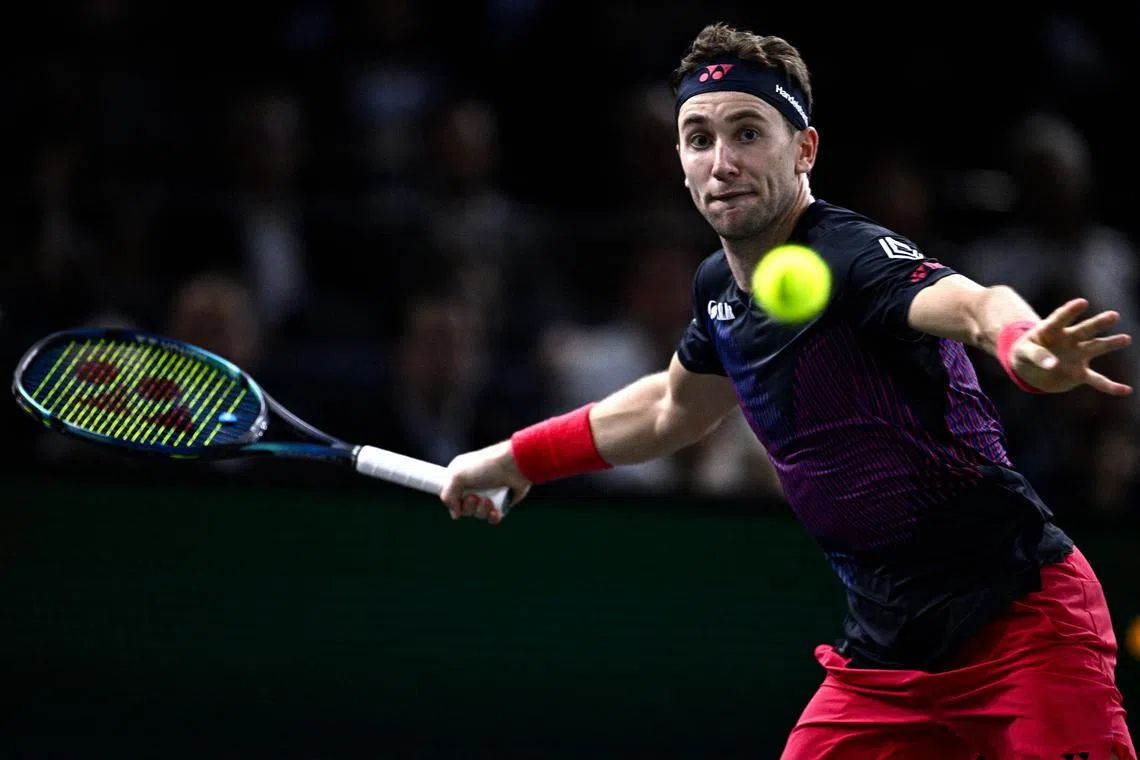Not all tennis balls are the same
Sign up now: Get the biggest sports news in your inbox

Norway's Casper Ruud eyes the ball as he plays against Australia's Jordan Thompson during the Paris Masters.
PHOTO: AFP
Follow topic:
NEW YORK – Yellow felt and a rubber core. A tennis ball seems so simple. But the reality is more complicated, at least on the pro tours where manufacturers can make balls that fit into a range of specifications.
And in recent years, with players forced to adjust to different balls at so many tournaments, they have begun complaining about the consistency and quality of the balls as never before.
Novak Djokovic spoke out. So did Rafael Nadal, Taylor Fritz, Daniil Medvedev, Stan Wawrinka and Andrey Rublev.
The varying balls not only harmed the quality of play, according to players and coaches, but the athletes blamed them for the increase in shoulder, elbow and, especially, wrist injuries.
“The quality of even the best balls has come down in the last few years,” said Craig Boynton, who coached Hubert Hurkacz. “They should not just be picking the ball that will pay the most money to be associated with a tournament, but what is the actual best ball.”
Lower-quality balls can feel like rocks early in a game then “get fluffed up like little kittens” after a few games, he added. When that happens, “players trying to muscle the ball more” by swinging with more force to make up for what the ball is lacking can get injured.
And Wayne Ferreira, Frances Tiafoe’s former coach, said that even when the balls were of high quality, there were too many different ones in play. Players often saw different brands each week.
“Some are heavier and some are lighter, and making that adjustment all the time is difficult,” he said.
The list of unhappy players grew so long that the ATP and WTA felt compelled to respond. Earlier in 2024, they promised a comprehensive review of the issue. Ross Hutchins, chief sporting officer of the ATP, said they had made enormous progress.
The ATP looked into manufacturing balls itself but instead decided the best solution was to centralise the ball-purchasing process that had long been left to individual tournaments.
They considered having one manufacturer for the entire season, but they instead set a goal of having only one ball – whether Wilson, Penn, Babolat, Dunlop or another – in use for each swing.
Hutchins added that a swing could range from a handful of tournaments to as many as 10 in a given region and on a specific surface.
So the year begins with a swing through Australia and New Zealand, followed by ones through the Middle East and North America. All of those tournaments are played outdoors on hard courts, but it is possible that each grouping will use a different ball.
Later in the year there will be one ball for the European clay-court swing, the grass-court swing and so on. The ATP is coordinating with the WTA to use the same balls as much as possible, especially where the men and women are playing in the same location.
“The ATP will do the negotiations and oversee the development of the ball with the manufacturers to get the best balls for each swing,” Hutchins said. The process began in 2024, and he said that as each deal ended between individual tournaments and manufacturers, the ATP would fold those tournaments into its centralised process.
Five more will be added in 2025, and by 2026 they will control more than 75 per cent of the tournaments, with 2029 as the target date for “full alignment where we control everything”, he added.
The exception is the Grand Slams, which operate independently of the ATP and WTA and have their own deals with ball manufacturers.
“The Slams are a major cog in the wheel of tennis, but we have tonnes of tournaments around them and can control what we can control,” Hutchins said.
He said the Australian and US Opens and Wimbledon have been good collaborators, so the balls used in the Slams will match those used in the tournaments leading up to them, with only the French Open as an exception – the ATP is using a Dunlop ball for the clay-court season, but the French Open has a deal with Wilson.
Ultimately, it is about consistency.
“We hit thousands of balls per day, which puts stress on your tendons and muscles, so this change would produce a more consistently high level of play and a better product for the sport and our fans,” said Matthew Ebden, president of the ATP’s player advisory council. NYTIMES

